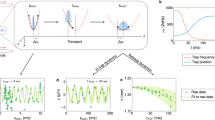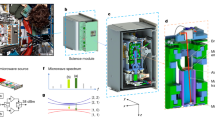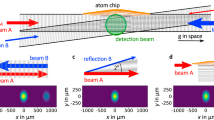Abstract
Quantum mechanics governs the microscopic world, where low mass and momentum reveal a natural wave–particle duality. Magnifying quantum behaviour to macroscopic scales is a major strength of the technique of cooling and trapping atomic gases, in which low momentum is engineered through extremely low temperatures. Advances in this field have achieved such precise control over atomic systems that gravity, often negligible when considering individual atoms, has emerged as a substantial obstacle. In particular, although weaker trapping fields would allow access to lower temperatures1,2, gravity empties atom traps that are too weak. Additionally, inertial sensors based on cold atoms could reach better sensitivities if the free-fall time of the atoms after release from the trap could be made longer3. Planetary orbit, specifically the condition of perpetual free-fall, offers to lift cold-atom studies beyond such terrestrial limitations. Here we report production of rubidium Bose–Einstein condensates (BECs) in an Earth-orbiting research laboratory, the Cold Atom Lab. We observe subnanokelvin BECs in weak trapping potentials with free-expansion times extending beyond one second, providing an initial demonstration of the advantages offered by a microgravity environment for cold-atom experiments and verifying the successful operation of this facility. With routine BEC production, continuing operations will support long-term investigations of trap topologies unique to microgravity4,5, atom-laser sources6, few-body physics7,8 and pathfinding techniques for atom-wave interferometry9,10,11,12.
This is a preview of subscription content, access via your institution
Access options
Access Nature and 54 other Nature Portfolio journals
Get Nature+, our best-value online-access subscription
$29.99 / 30 days
cancel any time
Subscribe to this journal
Receive 51 print issues and online access
$199.00 per year
only $3.90 per issue
Buy this article
- Purchase on Springer Link
- Instant access to full article PDF
Prices may be subject to local taxes which are calculated during checkout




Similar content being viewed by others
Data availability
Source data for Fig. 4 are provided with the paper. The datasets generated and analysed during the current study are available from the corresponding authors on reasonable request.
Change history
08 July 2020
The online publication date in the printed version of this article was listed incorrectly as 10 June 2020; the date was correct online.
17 July 2020
A Correction to this paper has been published: https://doi.org/10.1038/s41586-020-2517-0
References
Leanhardt, A. E. et al. Adiabatic and evaporative cooling of Bose–Einstein condensates below 500 picokelvin. Science 301, 1513–1515 (2003).
Ammann, H. & Christensen, N. Delta kick cooling: a new method for cooling atoms. Phys. Rev. Lett. 78, 2088–2091 (1997).
Safronova, M. et al. Search for new physics with atoms and molecules. Rev. Mod. Phys. 90, 025008 (2018).
Lundblad, N. Microgravity dynamics of bubble-geometry Bose-Einstein condensates. NASA Space Life and Physical Sciences Research and Applications Division Task Book (2017); https://taskbook.nasaprs.com/tbp/tbpdf.cfm?id=11095.
Lundblad, N. et al. Shell potentials for microgravity Bose-Einstein condensates. npj Microgravity 5, 30 (2019).
Meister, M., Roura, A., Rasel, E. M. & Schleich, W. P. The space atom laser: an isotropic source for ultra-cold atoms in microgravity. New J. Phys. 21, 013039 (2019).
Cornell, E. Zero-g studies of few-body and many-body physics. NASA Space Life and Physical Sciences Research and Applications Division Task Book (2017); https://taskbook.nasaprs.com/tbp/tbpdf.cfm?id=11096.
D’Incao, J. P., Krutzik, M., Elliott, E. & Williams, J. R. Enhanced association and dissociation of heteronuclear Feshbach molecules in a microgravity environment. Phys. Rev. A 95, 012701 (2017).
Bigelow, N. Consortium for ultracold atoms in space. NASA Space Life and Physical Sciences Research and Applications Division Task Book (2015); https://taskbook.nasaprs.com/tbp/tbpdf.cfm?id=10085.
Sackett, C. Development of atom interferometry experiments for the International Space Station’s cold atom laboratory. NASA Space Life and Physical Sciences Research and Applications Division Task Book (2017); https://taskbook.nasaprs.com/tbp/tbpdf.cfm?id=11097.
Sackett, C. A., Lam, T. C., Stickney, J. C. & Burke, J. H. Extreme adiabatic expansion in micro-gravity: modeling for the Cold Atomic Laboratory. Microgravity Sci. Technol. 30, 155–163 (2018).
Williams, J. Fundamental interactions for atom interferometry with ultracold quantum gases in a microgravity environment. NASA Space Life and Physical Sciences Research and Applications Division Task Book (2017); https://taskbook.nasaprs.com/tbp/tbpdf.cfm?id=11101.
National Research Council in Recapturing a Future for Space Exploration 249–262 (National Academies Press, 2011).
Kovachy, T. et al. Matter wave lensing to picokelvin temperatures. Phys. Rev. Lett. 114, 143004 (2015).
Kovachy, T. et al. Quantum superposition at the half-metre scale. Nature 528, 530–533 (2015).
Müntinga, H. et al. Interferometry with Bose–Einstein condensates in microgravity. Phys. Rev. Lett. 110, 093602 (2013).
van Zoest, T. et al. Bose–Einstein condensation in microgravity. Science 328, 1540–1543 (2010).
Kulas, S. et al. Miniaturized lab system for future cold atom experiments in microgravity. Microgravity Sci. Technol. 29, 37–48 (2017).
Condon, G. et al. All-optical Bose–Einstein condensates in microgravity. Phys. Rev. Lett. 123, 240402 (2019).
Stern, G. et al. Light-pulse atom interferometry in microgravity. Eur. Phys. J. D 53, 353–357 (2009).
Barrett, B. et al. Dual matter-wave inertial sensors in weightlessness. Nat. Commun. 7, 13786 (2016).
Altenbuchner, L. et al. MORABA—overview on DLR’s mobile rocket base and projects. In Proc. SpaceOps 2012 Conf. (American Institute of Aeronautics and Astronautics, 2012); https://doi.org/10.2514/6.2012-1272497.
Schkolnik, V. et al. A compact and robust diode laser system for atom interferometry on a sounding rocket. Appl. Phys. B 122, 217 (2016).
Lezius, M. et al. Space-borne frequency comb metrology. Optica 3, 1381–1387 (2016).
Dinkelaker, A. N. et al. Autonomous frequency stabilization of two extended-cavity diode lasers at the potassium wavelength on a sounding rocket. Appl. Opt. 56, 1388–1396 (2017).
Becker, D. et al. Space-borne Bose–Einstein condensation for precision interferometry. Nature 562, 391–395 (2018).
Williams, J. R., Chiow, S.-W., Yu, N. & Müller, H. Quantum test of the equivalence principle and space-time aboard the international space station. New J. Phys. 18, 025018 (2016).
Aguilera, D. N. et al. STE-QUEST-test of the universality of free fall using cold atom interferometry. Class. Quantum Gravity 31, 115010 (2014).
Kolkowitz, S. et al. Gravitational wave detection with optical lattice atomic clocks. Phys. Rev. D 94, 124043 (2016).
Hogan, J. M. & Kasevich, M. A. Atom-interferometric gravitational-wave detection using heterodyne laser links. Phys. Rev. A 94, 033632 (2016).
Hogan, J. M. et al. An atomic gravitational wave interferometric sensor in low Earth orbit (AGIS-LEO). Gen. Relativ. Gravit. 43, 1953–2009 (2011).
Yu, N. & Tinto, M. Gravitational wave detection with single-laser atom interferometers. Gen. Relativ. Gravit. 43, 1943–1952 (2011).
Kómár, P. et al. A quantum network of clocks. Nat. Phys. 10, 582–587 (2014).
Elder, B. et al. Chameleon dark energy and atom interferometry. Phys. Rev. D 94, 044051 (2016).
Yu, N., Kohel, J. M., Kellogg, J. R. & Maleki, L. Development of an atom-interferometer gravity gradiometer for gravity measurement from space. Appl. Phys. B 84, 647–652 (2006).
Sorrentino, F. et al. The space atom interferometer project: status and prospects. J. Phys. Conf. Ser. 327, 012050 (2011).
Chiow, S.-W. & Yu, N. Compact atom interferometer using single laser. Appl. Phys. B 124, 96 (2018).
Battelier, B. et al. Development of compact cold-atom sensors for inertial navigation. Proc. SPIE Quant. Opt. 9900, 990004 (2016).
Fang, B. et al. Metrology with atom interferometry: inertial sensors from laboratory to field applications. J. Phys. Conf. Ser. 723, 012049 (2016).
Elliott, E. R., Krutzik, M. C., Williams, J. R., Thompson, R. J. & Aveline, D. C. NASA’s Cold Atom Lab (CAL): system development and ground test status. npj Microgravity 4, 16 (2018).
Farkas, D. M., Salim, E. A. & Ramirez-Serrano, J. Production of rubidium Bose–Einstein condensates at a 1 Hz rate. Preprint at http://arXiv.org/abs/1403.4641v2 (2014).
Jenkins, F. A. & Segrè, E. The quadratic Zeeman effect. Phys. Rev. 55, 52–58 (1939).
Chaudhary, G. K., Chattopadhyay, A. & Ramakumar, R. Bose–Einstein condensate in a quartic potential: static and dynamic properties. Int. J. Mod. Phys. B 25, 3927–3940 (2012).
Tino, G. & Kasevich, M. Atom Interferometry (IOS Press, 2014).
Côté, R., Gould, P. L., Rozman, M. & Smith, W. S. (eds) Precision measurements. In Pushing the Frontiers of Atomic Physics: Proc. XXI Int. Conf. on Atomic Physics, 47–87 (World Scientific, 2009).
Frye, K. et al. The Bose–Einstein condensate and cold atom laboratory. Preprint at http://arXiv.org/abs/1912.04849 (2019).
Acknowledgements
We gratefully acknowledge the contributions of current and former members of CAL’s management and technical teams, T. Winn, K. Muse, L. Clonts, J. Lam, J. Liu, C. Tran, J. Tarsala, T. Tran, S. Haque, M. McKee, J. Trager, J. Mota, G. Miles, D. Strekalov, I. Li, S. Javidnia, A. Sengupta, D. Conroy, A. Croonquist, E. Burt, M. Krutzik, S. Kulas and V. Schkolnik, and the ColdQuanta team, including E. Salim, L. Czaia, J. Ramirez-Serrano, J. Duggan, and D. Anderson. We recognize the continuing support of JPL’s Astronomy, Physics and Space Technology Directorate, L. Livesay, T. Gaier, D. Coulter, C. Lawrence and U. Israelsson. We thank CAL’s principal investigators and science team members, N. Bigelow, N. Lundblad, C. Sackett, E. Cornell, P. Engels and M. Mossman, for their guidance, along with CAL’s Science Review Board, including B. DeMarco and R. Walsworth. We also recognize the steadfast support from NASA’s Division of Space, Life, and Physical Sciences Research and Applications (SLPSRA), C. Kundrot, D. Malarik, M. Lee, B. Carpenter and D. Griffin. This work was funded by NASA’s SLPSRA programme office, and operated by the Jet Propulsion Laboratory, California Institute of Technology, under contract with NASA. US Government sponsorship is acknowledged.
Author information
Authors and Affiliations
Contributions
D.C.A., J.R.W. and E.R.E. optimized and operated the instrument during the CAL commissioning phase, collected and analysed the associated data, and prepared this manuscript. D.C.A., J.R.W. and E.R.E. were responsible for instrument hardware integration, experimental operation, optimization and data acquisition during the CAL integration and test phase. D.C.A. led CAL’s ground testbed and the integration and testing of the science module hardware. J.R.W. led flight instrument operation and atom-interferometer-related tests. E.R.E. led integration and operation of CAL’s engineering model testbed. C.D. established and led the mission operations and ground data systems during commissioning. J.R.K. prepared and coordinated ISS installation procedures and operations. J.R.K. and J.M.K. led the laser and optics subsystems and operated the system post-commissioning. R.F.S., K.O., N.Y. and N.E.L. led technical planning and provided guidance across multiple subsystems during the integration and test phase. R.J.T. proposed the instrument, gave scientific guidance and coordinated with principal investigators as CAL project scientist. All authors read, edited and approved the final manuscript.
Corresponding authors
Ethics declarations
Competing interests
The authors declare no competing interests.
Additional information
Peer review information Nature thanks A. Roura and the other, anonymous, reviewer(s) for their contribution to the peer review of this work.
Publisher’s note Springer Nature remains neutral with regard to jurisdictional claims in published maps and institutional affiliations.
Extended data figures and tables
Extended Data Fig. 1 Science module optical beams.
a, An illustrative cross-section of the science module in the y–z plane, showing the optical beam paths for laser cooling and imaging. Collimators (depicted in blue) each accept optical fibre inputs and direct free-space beams into the vacuum chamber. In the source cell, elliptical beam collimators create a two-dimensional (2D) MOT (the x-axis collimator is not shown). A cold atomic beam is directed (its flux enhanced by the 2D MOT push beam) up to the UHV science cell, where >109 atoms are collected in a three-dimensional MOT. In this region, laser cooling beams labelled ‘MOT (a)’ and ‘MOT (b)’ are directed along the y–z plane, while a third collimator (not shown) sends its 11-mm-diameter beam (dotted circle) along the x-axis to complete the MOT. Each beam is retro-reflected by a mirror to create a full six-beam MOT located about 15 mm below the atom chip, which forms the topmost wall of the UHV chamber. CAL’s primary imaging beam (also 11 mm in diameter) is directed parallel to the chip surface along the y axis just under the chip, labelled as ‘Imaging (y)’. Fluorescence and absorption images along this axis are collected on the ‘CMOS (y)’ camera. Alternatively, through-chip imaging along the z axis can be collected by the ‘CMOS (z)’ camera, with an absorption imaging beam provided by the ‘Imaging (z)’ light that passes through a 0.75-mm-diameter aperture of the source cell. This aperture provides differential pumping to maintain UHV conditions in the science cell while the source cell runs at higher pressures of Rb and K. The background pressure of Rb and K is controlled by running independent current through each of two alkali metal dispensers: one containing Rb, and the other K. Atoms are collected in the MOT before undergoing molasses cooling and becoming confined by the coil-generated magnetic trap. The trapped cloud is then transported up 15 mm by a second pair of coils, and then loaded into the atom chip trap. b, A photograph of a science module without its front clam-shell of magnetic shields, showing the mechanical structure that rigidly supports the vacuum and optical hardware, as well as some of the thermal management components. More details of the science module and control hardware can be found in ref. 40.
Source data
Rights and permissions
About this article
Cite this article
Aveline, D.C., Williams, J.R., Elliott, E.R. et al. Observation of Bose–Einstein condensates in an Earth-orbiting research lab. Nature 582, 193–197 (2020). https://doi.org/10.1038/s41586-020-2346-1
Received:
Accepted:
Published:
Issue Date:
DOI: https://doi.org/10.1038/s41586-020-2346-1
This article is cited by
-
Low-dimensional quantum gases in curved geometries
Nature Reviews Physics (2023)
-
Coupled quantum vortex kinematics and Berry curvature in real space
Communications Physics (2023)
-
The space cold atom interferometer for testing the equivalence principle in the China Space Station
npj Microgravity (2023)
-
The Kostin Equation, the Deceleration of a Quantum Particle and Coherent Control
Journal of Low Temperature Physics (2023)
-
Quantum gas mixtures and dual-species atom interferometry in space
Nature (2023)
Comments
By submitting a comment you agree to abide by our Terms and Community Guidelines. If you find something abusive or that does not comply with our terms or guidelines please flag it as inappropriate.



